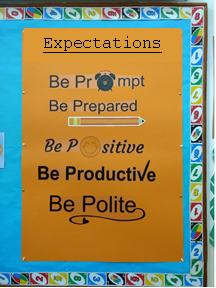Is the classroom matrix posted in a prominent location in the classroom that will encourage teaching of the expected behaviors?
 Once you have developed consistent classroom rules that follow the OMPUA guidelines, it is important to use that language on a regular basis. Having the expectations and rules displayed in the classroom in a big, bold way will make it easier for the classroom teacher to consistently use the language. Signage should directly match the expectations and rules from the matrix and should incorporate additional rules if applicable.
Once you have developed consistent classroom rules that follow the OMPUA guidelines, it is important to use that language on a regular basis. Having the expectations and rules displayed in the classroom in a big, bold way will make it easier for the classroom teacher to consistently use the language. Signage should directly match the expectations and rules from the matrix and should incorporate additional rules if applicable.
Signs and posters should be large enough for the teacher read from all areas of the classroom, or spaced around the room to enable the teacher to refer to them during academic instruction from various locations in the classroom.
Remember:
“You must define each routine ahead of time. Tell students exactly what you want them to do in observable and measurable terms.
“You must teach each routine to students, just like you teach academics. Don’t assume that students know how to meet expectations.
“You must prompt students to follow routines. Remind them of the expected behaviors—don’t wait for them to make an error.
“You must reinforce behavior that follows routines. Remember, behavior followed by pleasant consequences tends to be repeated. We want our students to repeat the behaviors that meet expectations, so we need to reinforce those behaviors.
“You must evaluate effectiveness and make adjustments as needed. Our decisions should be based on data.
“Although expectations used by effective educators may vary from teacher to teacher and school to school, we do not find effectively managed schools and classrooms operating without them.”
Carolyn Evertson, PhD – Peabody College, Vanderbilt University
Lesson References
MO SW-PBS Tier 1 Team Workbook 2018-19
Brophy, J. & Evertson, C. (1976). Learning from teaching: A developmental perspective. Boston, MA: Allyn and Bacon.
Simonsen, B., & Myers, D. (2015). Classwide positive behavior interventions and supports: A guide to proactive classroom management. New York, NY: Guilford Press

